Response to Ayad Akhtar’s American Dervish
VerifiedAdded on 2023/05/29
|6
|1605
|410
AI Summary
This essay analyzes Ayad Akhtar's American Dervish, exploring the conflict between Muslim and American culture, the role of women in Islamic society, and the types of Islam depicted in the novel.
Contribute Materials
Your contribution can guide someone’s learning journey. Share your
documents today.
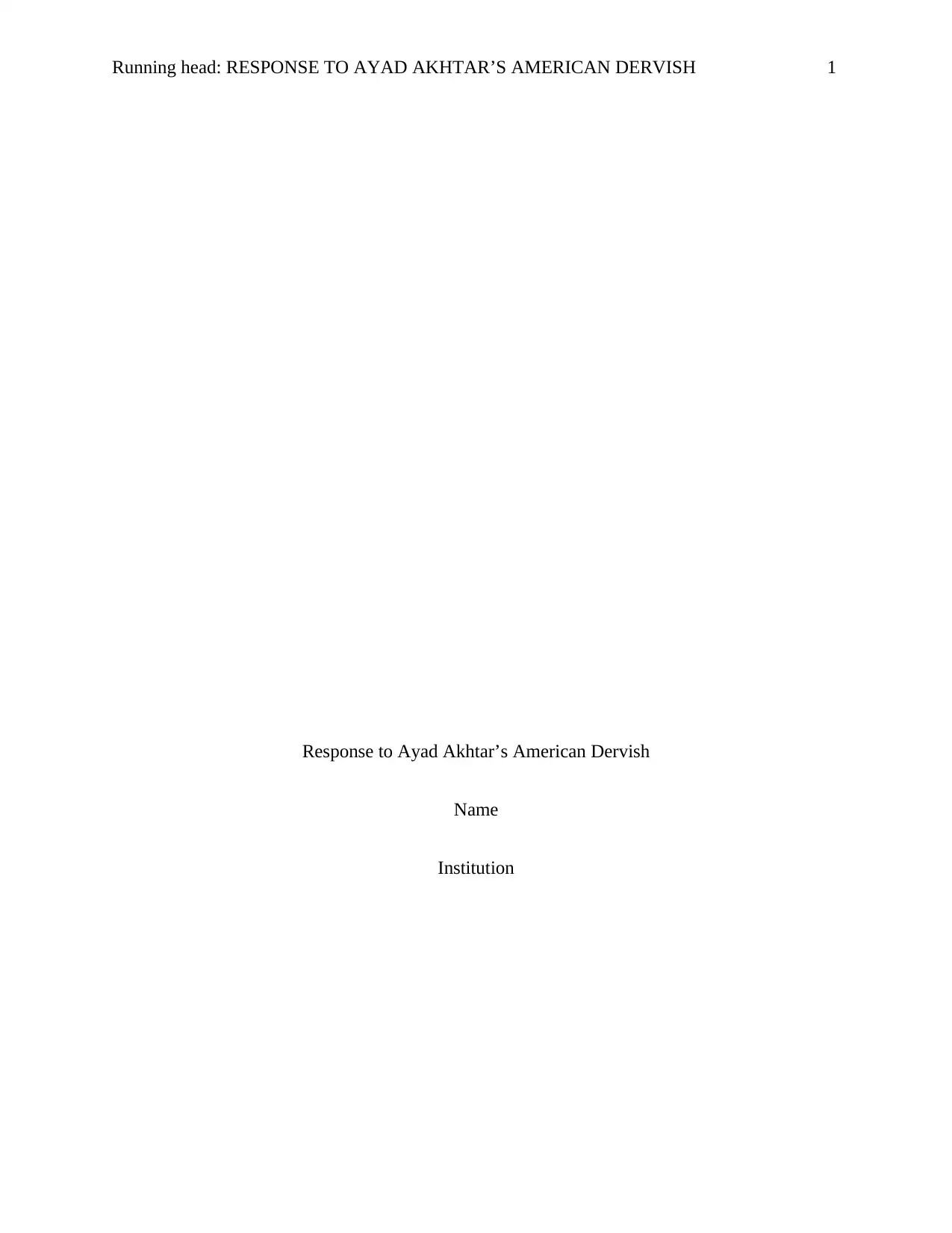
Running head: RESPONSE TO AYAD AKHTAR’S AMERICAN DERVISH 1
Response to Ayad Akhtar’s American Dervish
Name
Institution
Response to Ayad Akhtar’s American Dervish
Name
Institution
Secure Best Marks with AI Grader
Need help grading? Try our AI Grader for instant feedback on your assignments.
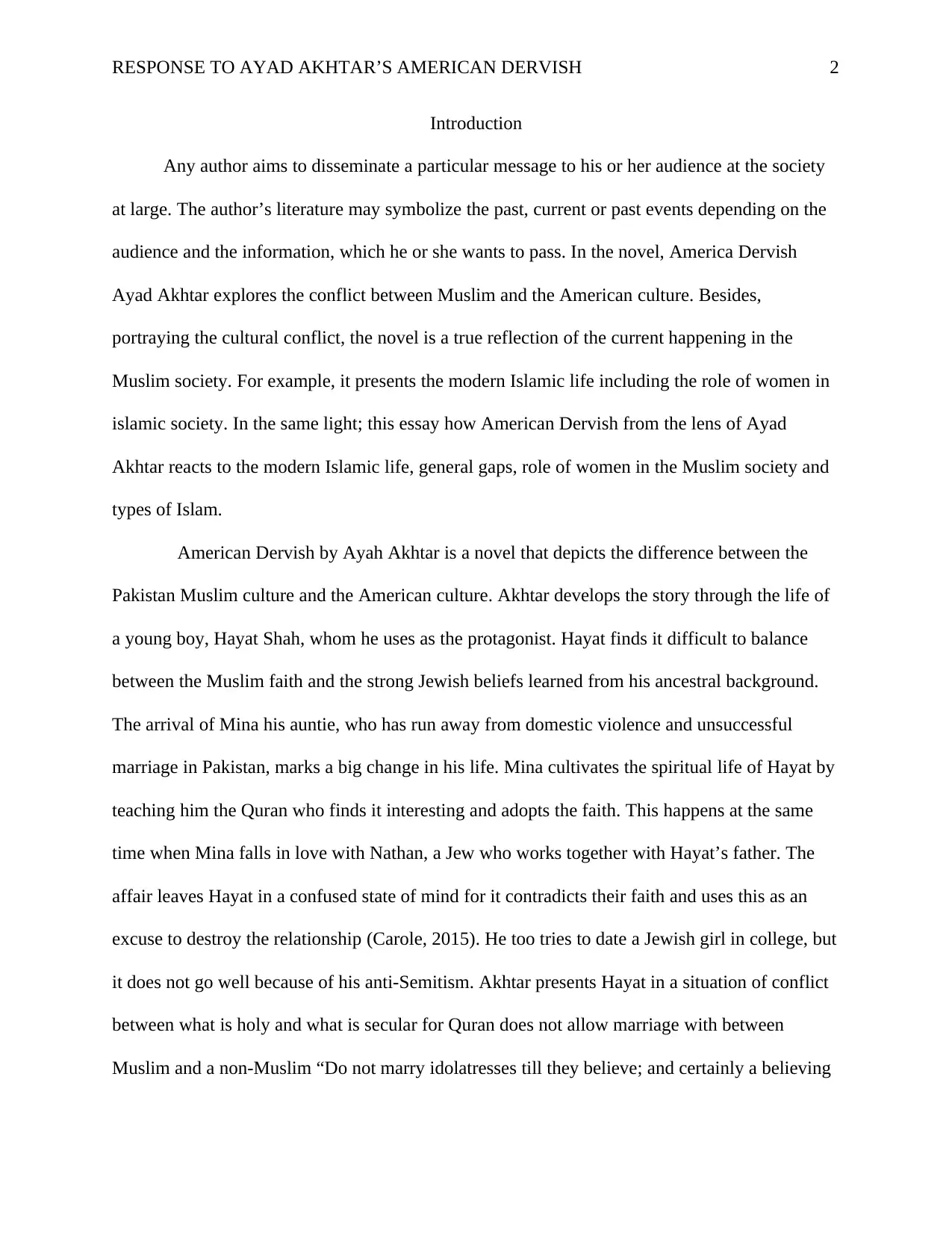
RESPONSE TO AYAD AKHTAR’S AMERICAN DERVISH 2
Introduction
Any author aims to disseminate a particular message to his or her audience at the society
at large. The author’s literature may symbolize the past, current or past events depending on the
audience and the information, which he or she wants to pass. In the novel, America Dervish
Ayad Akhtar explores the conflict between Muslim and the American culture. Besides,
portraying the cultural conflict, the novel is a true reflection of the current happening in the
Muslim society. For example, it presents the modern Islamic life including the role of women in
islamic society. In the same light; this essay how American Dervish from the lens of Ayad
Akhtar reacts to the modern Islamic life, general gaps, role of women in the Muslim society and
types of Islam.
American Dervish by Ayah Akhtar is a novel that depicts the difference between the
Pakistan Muslim culture and the American culture. Akhtar develops the story through the life of
a young boy, Hayat Shah, whom he uses as the protagonist. Hayat finds it difficult to balance
between the Muslim faith and the strong Jewish beliefs learned from his ancestral background.
The arrival of Mina his auntie, who has run away from domestic violence and unsuccessful
marriage in Pakistan, marks a big change in his life. Mina cultivates the spiritual life of Hayat by
teaching him the Quran who finds it interesting and adopts the faith. This happens at the same
time when Mina falls in love with Nathan, a Jew who works together with Hayat’s father. The
affair leaves Hayat in a confused state of mind for it contradicts their faith and uses this as an
excuse to destroy the relationship (Carole, 2015). He too tries to date a Jewish girl in college, but
it does not go well because of his anti-Semitism. Akhtar presents Hayat in a situation of conflict
between what is holy and what is secular for Quran does not allow marriage with between
Muslim and a non-Muslim “Do not marry idolatresses till they believe; and certainly a believing
Introduction
Any author aims to disseminate a particular message to his or her audience at the society
at large. The author’s literature may symbolize the past, current or past events depending on the
audience and the information, which he or she wants to pass. In the novel, America Dervish
Ayad Akhtar explores the conflict between Muslim and the American culture. Besides,
portraying the cultural conflict, the novel is a true reflection of the current happening in the
Muslim society. For example, it presents the modern Islamic life including the role of women in
islamic society. In the same light; this essay how American Dervish from the lens of Ayad
Akhtar reacts to the modern Islamic life, general gaps, role of women in the Muslim society and
types of Islam.
American Dervish by Ayah Akhtar is a novel that depicts the difference between the
Pakistan Muslim culture and the American culture. Akhtar develops the story through the life of
a young boy, Hayat Shah, whom he uses as the protagonist. Hayat finds it difficult to balance
between the Muslim faith and the strong Jewish beliefs learned from his ancestral background.
The arrival of Mina his auntie, who has run away from domestic violence and unsuccessful
marriage in Pakistan, marks a big change in his life. Mina cultivates the spiritual life of Hayat by
teaching him the Quran who finds it interesting and adopts the faith. This happens at the same
time when Mina falls in love with Nathan, a Jew who works together with Hayat’s father. The
affair leaves Hayat in a confused state of mind for it contradicts their faith and uses this as an
excuse to destroy the relationship (Carole, 2015). He too tries to date a Jewish girl in college, but
it does not go well because of his anti-Semitism. Akhtar presents Hayat in a situation of conflict
between what is holy and what is secular for Quran does not allow marriage with between
Muslim and a non-Muslim “Do not marry idolatresses till they believe; and certainly a believing
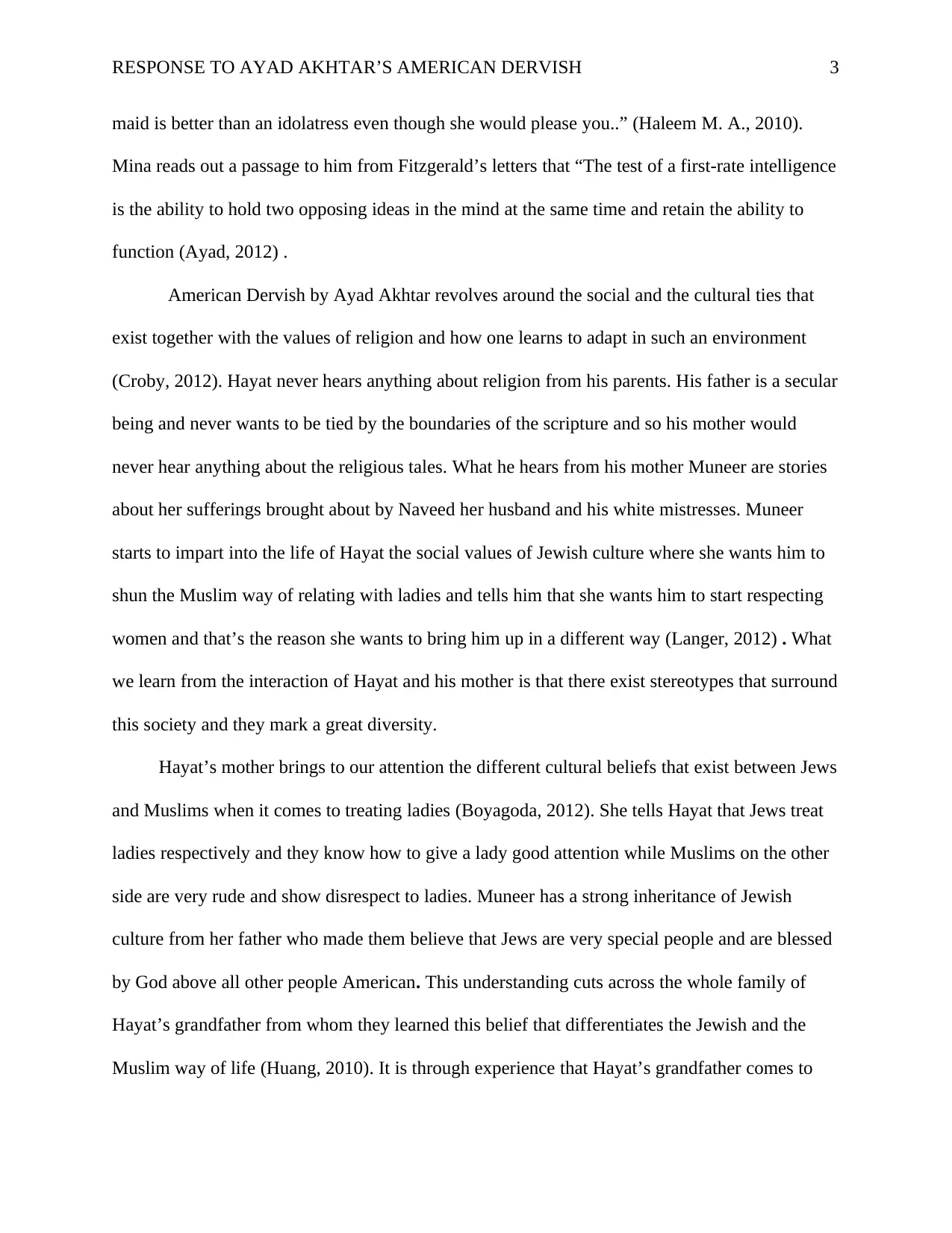
RESPONSE TO AYAD AKHTAR’S AMERICAN DERVISH 3
maid is better than an idolatress even though she would please you..” (Haleem M. A., 2010).
Mina reads out a passage to him from Fitzgerald’s letters that “The test of a first-rate intelligence
is the ability to hold two opposing ideas in the mind at the same time and retain the ability to
function (Ayad, 2012) .
American Dervish by Ayad Akhtar revolves around the social and the cultural ties that
exist together with the values of religion and how one learns to adapt in such an environment
(Croby, 2012). Hayat never hears anything about religion from his parents. His father is a secular
being and never wants to be tied by the boundaries of the scripture and so his mother would
never hear anything about the religious tales. What he hears from his mother Muneer are stories
about her sufferings brought about by Naveed her husband and his white mistresses. Muneer
starts to impart into the life of Hayat the social values of Jewish culture where she wants him to
shun the Muslim way of relating with ladies and tells him that she wants him to start respecting
women and that’s the reason she wants to bring him up in a different way (Langer, 2012) . What
we learn from the interaction of Hayat and his mother is that there exist stereotypes that surround
this society and they mark a great diversity.
Hayat’s mother brings to our attention the different cultural beliefs that exist between Jews
and Muslims when it comes to treating ladies (Boyagoda, 2012). She tells Hayat that Jews treat
ladies respectively and they know how to give a lady good attention while Muslims on the other
side are very rude and show disrespect to ladies. Muneer has a strong inheritance of Jewish
culture from her father who made them believe that Jews are very special people and are blessed
by God above all other people American. This understanding cuts across the whole family of
Hayat’s grandfather from whom they learned this belief that differentiates the Jewish and the
Muslim way of life (Huang, 2010). It is through experience that Hayat’s grandfather comes to
maid is better than an idolatress even though she would please you..” (Haleem M. A., 2010).
Mina reads out a passage to him from Fitzgerald’s letters that “The test of a first-rate intelligence
is the ability to hold two opposing ideas in the mind at the same time and retain the ability to
function (Ayad, 2012) .
American Dervish by Ayad Akhtar revolves around the social and the cultural ties that
exist together with the values of religion and how one learns to adapt in such an environment
(Croby, 2012). Hayat never hears anything about religion from his parents. His father is a secular
being and never wants to be tied by the boundaries of the scripture and so his mother would
never hear anything about the religious tales. What he hears from his mother Muneer are stories
about her sufferings brought about by Naveed her husband and his white mistresses. Muneer
starts to impart into the life of Hayat the social values of Jewish culture where she wants him to
shun the Muslim way of relating with ladies and tells him that she wants him to start respecting
women and that’s the reason she wants to bring him up in a different way (Langer, 2012) . What
we learn from the interaction of Hayat and his mother is that there exist stereotypes that surround
this society and they mark a great diversity.
Hayat’s mother brings to our attention the different cultural beliefs that exist between Jews
and Muslims when it comes to treating ladies (Boyagoda, 2012). She tells Hayat that Jews treat
ladies respectively and they know how to give a lady good attention while Muslims on the other
side are very rude and show disrespect to ladies. Muneer has a strong inheritance of Jewish
culture from her father who made them believe that Jews are very special people and are blessed
by God above all other people American. This understanding cuts across the whole family of
Hayat’s grandfather from whom they learned this belief that differentiates the Jewish and the
Muslim way of life (Huang, 2010). It is through experience that Hayat’s grandfather comes to
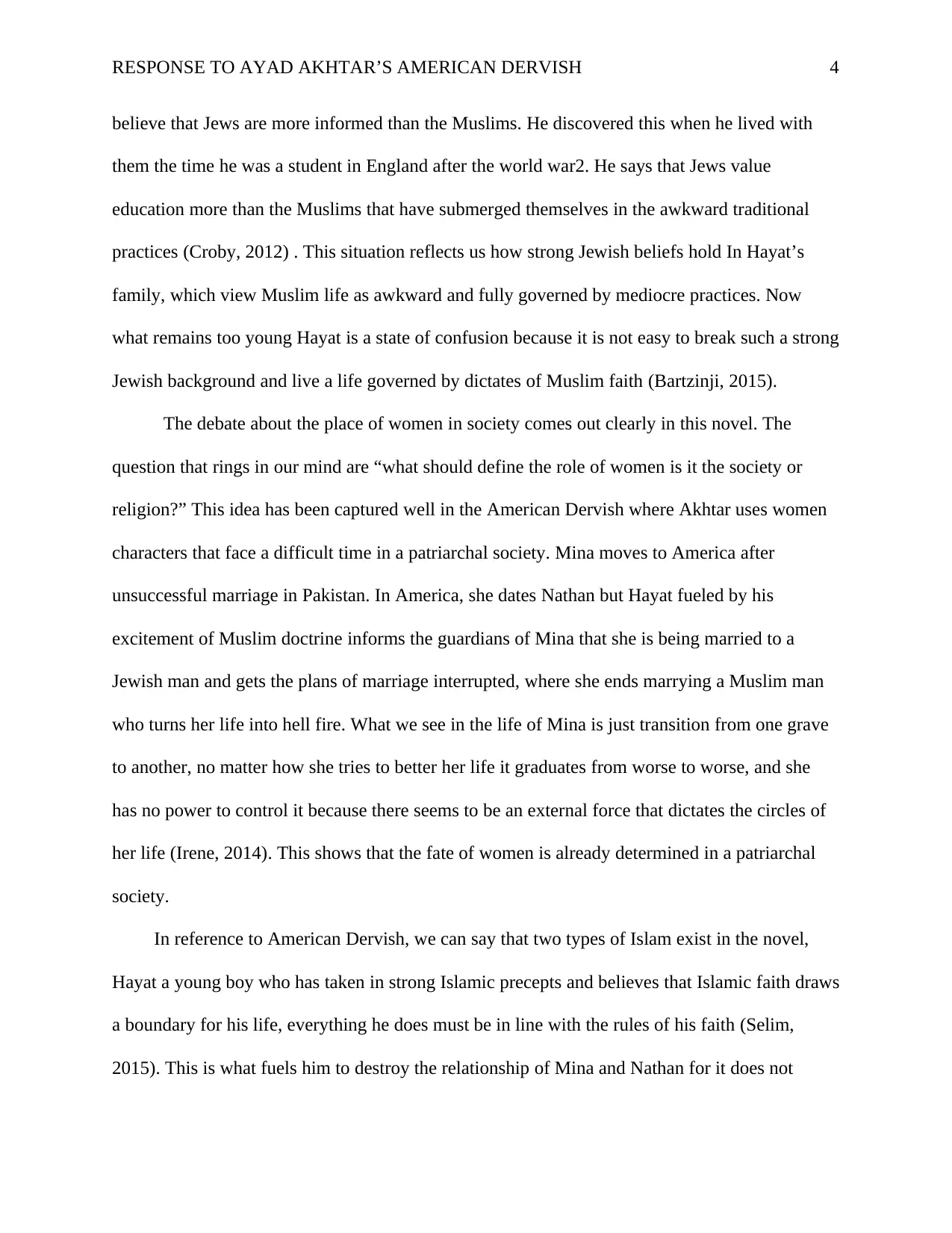
RESPONSE TO AYAD AKHTAR’S AMERICAN DERVISH 4
believe that Jews are more informed than the Muslims. He discovered this when he lived with
them the time he was a student in England after the world war2. He says that Jews value
education more than the Muslims that have submerged themselves in the awkward traditional
practices (Croby, 2012) . This situation reflects us how strong Jewish beliefs hold In Hayat’s
family, which view Muslim life as awkward and fully governed by mediocre practices. Now
what remains too young Hayat is a state of confusion because it is not easy to break such a strong
Jewish background and live a life governed by dictates of Muslim faith (Bartzinji, 2015).
The debate about the place of women in society comes out clearly in this novel. The
question that rings in our mind are “what should define the role of women is it the society or
religion?” This idea has been captured well in the American Dervish where Akhtar uses women
characters that face a difficult time in a patriarchal society. Mina moves to America after
unsuccessful marriage in Pakistan. In America, she dates Nathan but Hayat fueled by his
excitement of Muslim doctrine informs the guardians of Mina that she is being married to a
Jewish man and gets the plans of marriage interrupted, where she ends marrying a Muslim man
who turns her life into hell fire. What we see in the life of Mina is just transition from one grave
to another, no matter how she tries to better her life it graduates from worse to worse, and she
has no power to control it because there seems to be an external force that dictates the circles of
her life (Irene, 2014). This shows that the fate of women is already determined in a patriarchal
society.
In reference to American Dervish, we can say that two types of Islam exist in the novel,
Hayat a young boy who has taken in strong Islamic precepts and believes that Islamic faith draws
a boundary for his life, everything he does must be in line with the rules of his faith (Selim,
2015). This is what fuels him to destroy the relationship of Mina and Nathan for it does not
believe that Jews are more informed than the Muslims. He discovered this when he lived with
them the time he was a student in England after the world war2. He says that Jews value
education more than the Muslims that have submerged themselves in the awkward traditional
practices (Croby, 2012) . This situation reflects us how strong Jewish beliefs hold In Hayat’s
family, which view Muslim life as awkward and fully governed by mediocre practices. Now
what remains too young Hayat is a state of confusion because it is not easy to break such a strong
Jewish background and live a life governed by dictates of Muslim faith (Bartzinji, 2015).
The debate about the place of women in society comes out clearly in this novel. The
question that rings in our mind are “what should define the role of women is it the society or
religion?” This idea has been captured well in the American Dervish where Akhtar uses women
characters that face a difficult time in a patriarchal society. Mina moves to America after
unsuccessful marriage in Pakistan. In America, she dates Nathan but Hayat fueled by his
excitement of Muslim doctrine informs the guardians of Mina that she is being married to a
Jewish man and gets the plans of marriage interrupted, where she ends marrying a Muslim man
who turns her life into hell fire. What we see in the life of Mina is just transition from one grave
to another, no matter how she tries to better her life it graduates from worse to worse, and she
has no power to control it because there seems to be an external force that dictates the circles of
her life (Irene, 2014). This shows that the fate of women is already determined in a patriarchal
society.
In reference to American Dervish, we can say that two types of Islam exist in the novel,
Hayat a young boy who has taken in strong Islamic precepts and believes that Islamic faith draws
a boundary for his life, everything he does must be in line with the rules of his faith (Selim,
2015). This is what fuels him to destroy the relationship of Mina and Nathan for it does not
Secure Best Marks with AI Grader
Need help grading? Try our AI Grader for instant feedback on your assignments.
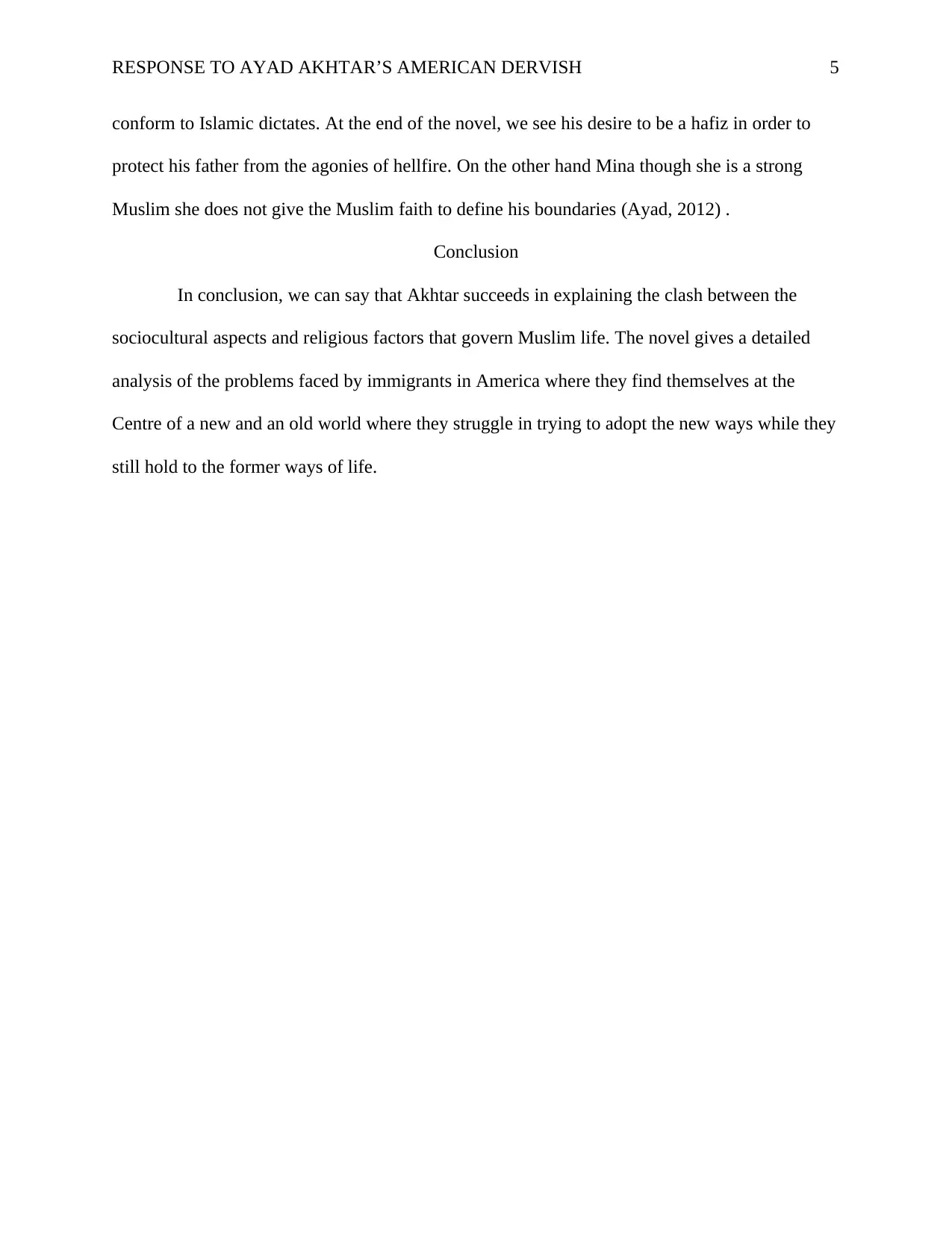
RESPONSE TO AYAD AKHTAR’S AMERICAN DERVISH 5
conform to Islamic dictates. At the end of the novel, we see his desire to be a hafiz in order to
protect his father from the agonies of hellfire. On the other hand Mina though she is a strong
Muslim she does not give the Muslim faith to define his boundaries (Ayad, 2012) .
Conclusion
In conclusion, we can say that Akhtar succeeds in explaining the clash between the
sociocultural aspects and religious factors that govern Muslim life. The novel gives a detailed
analysis of the problems faced by immigrants in America where they find themselves at the
Centre of a new and an old world where they struggle in trying to adopt the new ways while they
still hold to the former ways of life.
conform to Islamic dictates. At the end of the novel, we see his desire to be a hafiz in order to
protect his father from the agonies of hellfire. On the other hand Mina though she is a strong
Muslim she does not give the Muslim faith to define his boundaries (Ayad, 2012) .
Conclusion
In conclusion, we can say that Akhtar succeeds in explaining the clash between the
sociocultural aspects and religious factors that govern Muslim life. The novel gives a detailed
analysis of the problems faced by immigrants in America where they find themselves at the
Centre of a new and an old world where they struggle in trying to adopt the new ways while they
still hold to the former ways of life.
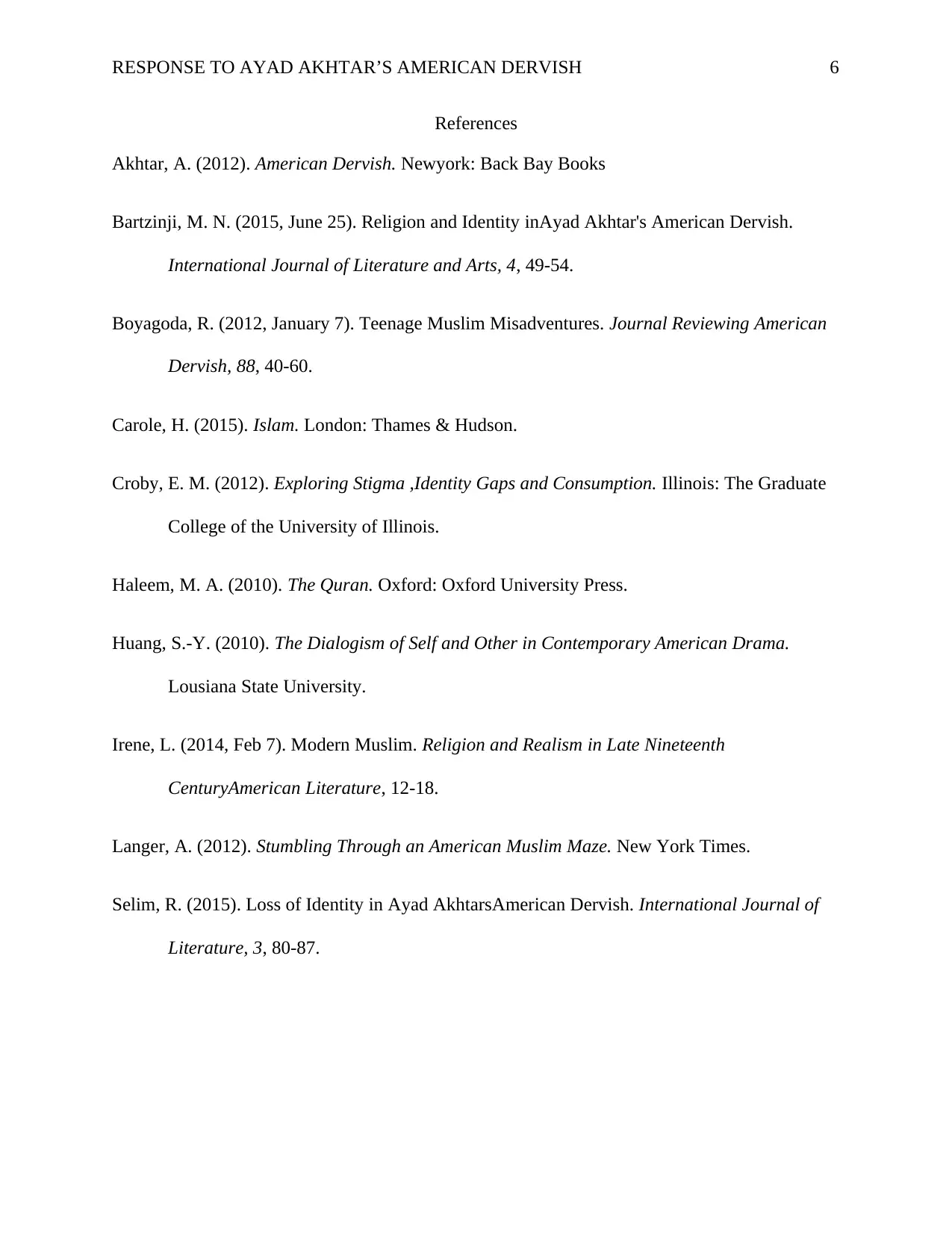
RESPONSE TO AYAD AKHTAR’S AMERICAN DERVISH 6
References
Akhtar, A. (2012). American Dervish. Newyork: Back Bay Books
Bartzinji, M. N. (2015, June 25). Religion and Identity inAyad Akhtar's American Dervish.
International Journal of Literature and Arts, 4, 49-54.
Boyagoda, R. (2012, January 7). Teenage Muslim Misadventures. Journal Reviewing American
Dervish, 88, 40-60.
Carole, H. (2015). Islam. London: Thames & Hudson.
Croby, E. M. (2012). Exploring Stigma ,Identity Gaps and Consumption. Illinois: The Graduate
College of the University of Illinois.
Haleem, M. A. (2010). The Quran. Oxford: Oxford University Press.
Huang, S.-Y. (2010). The Dialogism of Self and Other in Contemporary American Drama.
Lousiana State University.
Irene, L. (2014, Feb 7). Modern Muslim. Religion and Realism in Late Nineteenth
CenturyAmerican Literature, 12-18.
Langer, A. (2012). Stumbling Through an American Muslim Maze. New York Times.
Selim, R. (2015). Loss of Identity in Ayad AkhtarsAmerican Dervish. International Journal of
Literature, 3, 80-87.
References
Akhtar, A. (2012). American Dervish. Newyork: Back Bay Books
Bartzinji, M. N. (2015, June 25). Religion and Identity inAyad Akhtar's American Dervish.
International Journal of Literature and Arts, 4, 49-54.
Boyagoda, R. (2012, January 7). Teenage Muslim Misadventures. Journal Reviewing American
Dervish, 88, 40-60.
Carole, H. (2015). Islam. London: Thames & Hudson.
Croby, E. M. (2012). Exploring Stigma ,Identity Gaps and Consumption. Illinois: The Graduate
College of the University of Illinois.
Haleem, M. A. (2010). The Quran. Oxford: Oxford University Press.
Huang, S.-Y. (2010). The Dialogism of Self and Other in Contemporary American Drama.
Lousiana State University.
Irene, L. (2014, Feb 7). Modern Muslim. Religion and Realism in Late Nineteenth
CenturyAmerican Literature, 12-18.
Langer, A. (2012). Stumbling Through an American Muslim Maze. New York Times.
Selim, R. (2015). Loss of Identity in Ayad AkhtarsAmerican Dervish. International Journal of
Literature, 3, 80-87.
1 out of 6
Your All-in-One AI-Powered Toolkit for Academic Success.
+13062052269
info@desklib.com
Available 24*7 on WhatsApp / Email
![[object Object]](/_next/static/media/star-bottom.7253800d.svg)
Unlock your academic potential
© 2024 | Zucol Services PVT LTD | All rights reserved.